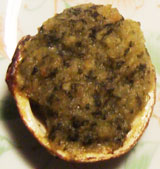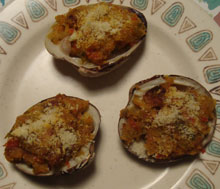Clams Ahoy!
Everything you always wanted to know about Clams but were afraid to ask!!
Mahogany Clams
Small Mahogany colored Ocean Quahogs from Maine
Maine Mahogany Clams are smaller ocean quahogs harvested off the coast of Maine that have a mahogany color. At one point they were considered a separate clam species but are now considered to be ocean quahogs. They are cheap and we like them but not as much as littlenecks - read on:
There are two types of quahogs. The
Ocean Quahog, Arctica islandica,
is the larger and often confused with
 the smaller Quahog, Mercenaria mercenaria, which is also
called a Littleneck or Cherrystone depending on size. Mahogany clams are
Ocean Quahogs, Arctica islandica.
the smaller Quahog, Mercenaria mercenaria, which is also
called a Littleneck or Cherrystone depending on size. Mahogany clams are
Ocean Quahogs, Arctica islandica.
To the side you'll see Maine mahogany clams with two
littleneck clams on top to show relative sizes. The mahoganys ranged
from 2 1/4 to to 2 1/2 inches across.
While the quahog is often harvested in shallow water by hand, many times with a clam rake, the ocean quahog lives too deep for harvesting by hand, beyond the intertidal zone, and is harvested by dredging. Most ocean quahogs are 4 to 8 inches and have tough meat and are used in chowders and sauces, but the mahogany clam is smaller, perhaps 2 1/2 inches, cherrystone size, and are sold for steaming, cooking with pasta, and similar uses.
Mahogany clams are much cheaper than quahogs. For example, I bought a dozen for 19 cents each while smaller quahogs, namely littlenecks, were 49 cents a piece. There is a reason they are cheaper as our taste test showed. They do not taste as good plain, but can be prepared quite well, and have their uses in the kitchen.
First I grilled a couple of each and ate them plain. The littlenecks were wonderful and sweet, while the mahogany clams were good but stronger tasting, perhaps a bit saltier, and definitely tougher. In part they may have been tougher as they were larger as the pictures show.
I also steamed them in plain water. Once again, the
results were similar, with the littlenecks kicking butt over the Maine
Mahogany clams.
I also steamed with with olive oil, garlic, onion, vermouth, lemon and basil. I put a little olive oil in a pan and gently and slightly sautéed some minced garlic and finely chopped onion. I added enough dry vermouth to fill the pan to about 3/8 of an inch, add some fresh lemon juice and freshly chopped basil. Once the mixture was boiling, I added the clams and steamed until they opened. This was no culinary masterpiece, just a quick experiment.
These clams were entirely different! Although I still preferred the littlenecks, the mahoganys were much better and it was nice having both for contrast.
Additional Maine Mahogany Clam experiments a few weeks later:
 Since
the best preparation was the fanciest, I also decided to try Clams
Rockefeller (basically the famous Oysters Rockefeller made with Mahogany
clams) and Clams Casino with Mahoganys as well.
Since
the best preparation was the fanciest, I also decided to try Clams
Rockefeller (basically the famous Oysters Rockefeller made with Mahogany
clams) and Clams Casino with Mahoganys as well.
Oysters Rockefeller was first created in 1899 at Antoine's
Restaurant in New Orleans, and consists of oysters on the half shell topped
with spinach and more vegetables together with other ingredients and then
baked or broiled. Although the exact recipe may have gone to its grave with
its founder, I used an
Emeril Lagasse recipe which had onions, spinach,
garlic, breadcrumbs/cracker crumbs, butter and more. The Mahogany Clams Rockefeller was pretty good, but the Oysters Rockefeller I made at the same
time was better.
I also decided to try them Clams Casino style, and this is the best preparation to date I've found. This is made of clams on the half shell with a topping that includes peppers (I mixed green and red), bacon or pancetta, shallots, garlic, parmesan cheese and breadcrumbs. There are several similar recipes available online.
Mahogany Clams Casino was a winner. Yes, I preferred the littlenecks done this way slightly better, but having both was awesome. This is the best preparation I've found to date!
Now your mileage may vary, but if you are an absolute clam lover you will like mahogany clams regardless of how they are prepared. Although more clam experimentation is necessary, mahogany clams work well in dishes that contain additional flavors and spices. I'm thinking of trying them in a stew, perhaps Ciopinno, and in pasta sauces. Oh yes, I shall need to try them raw on the half shell as well.
 Hi,
we are Ted and John, just two guys who love Clams and other seafood.
Hi,
we are Ted and John, just two guys who love Clams and other seafood.